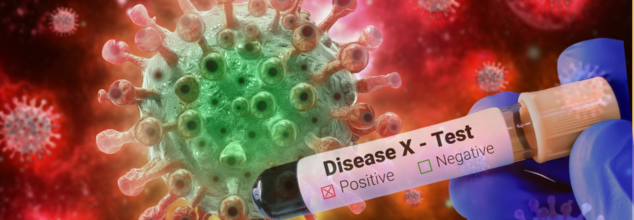
Disease X Is A Deadlier Threat Than COVID: 4 Viruses That Could Spark The Next Pandemic
When COVID-19 shut the world down in 2020, it also raised a worldwide alarm—pandemics of the future are not a question of if, but when. Now, British public health officials unveiled a chilling array of possible viral dangers that would cause the next global health crisis, ominously dubbed "Disease X." Four families of viruses have the highest pandemic risk, according to the UK Health Security Agency (UKHSA). These diseases are not yet common household names, but the danger they pose is very real—and possibly more catastrophic than the new coronavirus.
"Disease X" was a term that the World Health Organization (WHO) used to represent a hypothetical, yet undetermined pathogen that might cause an impending epidemic. It was used to recognize the increasing danger of unknown illnesses that may initiate global outbreaks in an era with rapidly growing population densities, climate change, and spillovers from animals to humans.
According to a recent study, the UKHSA examined 24 families of viruses and identified four most likely to instigate the forthcoming pandemic: Paramyxoviridae, Picornaviridae, Coronaviridae, and Orthomyxoviridae. These infections, with the nature they hold and the experience they have generated, can produce widespread diseases as well as death if they aren't kept at bay.
Four High-Risk Viral Families Identified
1. Paramyxoviridae: Measles-like Viruses and Nipah
This family includes the measles virus and the Nipah virus, both capable of causing severe complications. Measles, while vaccine-preventable, is resurging globally due to declining immunization rates. It’s not just a childhood illness; measles can lead to encephalitis (brain swelling), pneumonia, and even permanent disabilities like blindness or hearing loss.
A 2019 Harvard Medical School study revealed that measles can destroy up to 75% of the immune system's memory, leaving people more susceptible to other illnesses. Worse still, if a new measles-like virus were to arise, specialists worry it would be both highly infectious and fatal—particularly among children.
"Nipah virus," on the other hand, is recognized for Southeast Asian outbreaks. Spread from animals, particularly bats, it leads to fever, respiratory distress, and inflammation of the brain with a mortality rate of 40% to 75%.
2. Picornaviridae: Polio-like Disease in Disguise
The enteroviruses within this family are known to cause such diseases as acute flaccid myelitis (AFM)—a paralytic illness similar to polio. AFM usually affects children with sudden muscle weakness and, in extreme cases, permanent paralysis. Although infrequent, its unwieldy outbreaks have put the world's neurologists on notice.
3. Coronaviridae: The Return of a Familiar Foe
This group contains COVID-19 and MERS, the latter still producing sporadic outbreaks with high mortality, chiefly in the Middle East. As the world knows COVID-19 well, as yet undiscovered and new coronaviruses might still appear that are more dangerous or more resilient to current vaccines.
4. Orthomyxoviridae: Influenza's Deadlier Cousins
From avian influenza to seasonal flu, this family has repeatedly demonstrated its pandemic potential. Human bird flu outbreaks have already happened, and scientists caution that even a minor genetic shift may result in more effective human-to-human transmission.
Could the Next Pandemic Be Worse Than COVID-19?
Professor Mark Woolhouse, one of the UK's top infectious disease experts at the University of Edinburgh, warns that a new measles-like virus would be a threat "far worse than COVID-19." While SARS-CoV-2 spared children for the most part from severe illness, a virus in the Paramyxoviridae family could be very infectious, very deadly, and strike younger populations. Lockdowns, Woolhouse says, may not even work to prevent it.
The Coalition for Epidemic Preparedness Innovations (CEPI) and other global health organizations are racing toward a revolutionary objective: developing vaccines in 100 days after a new disease is discovered. That's a stark contrast with the COVID-19 vaccine timeline—Pfizer's took 337 days, and previously, the fastest vaccine ever made (for mumps) took four years.
CEPI plans to construct a library of "prototype vaccines" for 25 known virus families. These would be blueprints, enabling scientists to switch quickly and initiate human trials in record time if Disease X arises.
Nevertheless, the experts contend that even 100 days may prove to be late. A study published recently in The Lancet indicates that had the COVID-19 vaccine been made available within three months of the virus having been sequenced, millions of lives would have been saved.
Are Viral Hemorrhagic Fevers the Overlooked Threat?
Another category of viruses—viral hemorrhagic fevers (VHFs)—also hang over the horizon. Viruses such as Dengue, Ebola, Marburg, Lassa, and Yellow Fever cause massive bleeding, organ failure, and death. While some are geographically localized and rare, others such as Dengue are already global threats in the making.
The clinical manifestations of VHFs vary from fever and malaise to intravascular hemorrhage and organ dysfunction. Most VHFs are zoonotic, spilling over from bats, rodents, and primates. Although there are vaccines available for some (e.g., Yellow Fever), several lack efficient treatments or have poor vaccine coverage.
UKHSA's Dr. Isabel Oliver stresses that "infectious diseases don't respect borders." With a world of rapid travel, shifting climates, and vaccine skepticism, the recipe for a global health catastrophe is already in place.
The UK's "Priority Pathogens" approach is all part of a broader strategy to not only identify threats, but to prepare for them with cutting-edge surveillance, quick vaccine platforms, and international collaboration.
India's recent achievement of developing its first indigenous dengue vaccine marks progress, particularly in middle-income countries. But the question remains: will we be prepared when the true "Disease X" arrives?
The answer is not in panic, but in readiness driven by science, global collaboration, and a sense of urgency based on the lessons of our recent past.

(Credit-Canva)
Amid Conflicting Bird Flu Reports, Parents Are Struggling To Find Reliable Information For Kids Safety
As bird flu progresses in US, parents along with other concerned citizens of the country are scrambling to get information about it. Centers of Disease Control and Prevention (CDC) explains that while the current risk is low, they are working towards bettering the situation with the help of state and monitoring people with animal exposure.
It's hard for parents to know what's really going on with bird flu. A recent survey done by University of Michigan Health C.S. Mott Children's Hospital National Poll on Children's Health showed that many parents just can't find good, trustworthy information. Parents don't know who to believe or where to look which makes them feel worried and unsure about how to keep their families safe. It is important to know the real facts, but it's tough when they find varied reports everywhere. Some parents think the news is making it sound worse than it is, while others are concerned that not enough is being done.
What Are Parents Concerned About?
Many parents are feeling lost when trying to find information about bird flu. They see different stories online and on TV, and they don't know what's true. This makes them worry because they want to protect their kids. Parents mostly rely on news reports (78%) for information, while others use social media is also a common source (31%). The rest turn to the internet (19%), family and friends (15%), government agencies (11%) and health care providers (11%) .
Parents are worried about bird flu spreading to people. They're scared that animals could give it to humans, or that people could give it to each other. They're also not sure if the government can handle a big outbreak. They don't have much confidence that the government can get rid of infected animals or food. They're also worried that they won't get clear information about recalls or how to get rid of dangerous products. They just want to feel like someone is in control.
The survey also revealed that one-third of the parents took action to protect their family against the bird flu, while 22% were being more careful about the hygiene. Of them, 13% were cautious handling eggs, chicken and other meat products, 12% avoid contact with birds, and 10% avoided raw milk.
Flu viruses can infect chicken eggs by entering through the eggshell. The eggshells are smaller than the pores of eggshells, which means viruses can enter the eggs and the egg's surface will still be protected. However, it is still important to handle it safely.
As per the US Food and Drug Administration, cooking poultry, eggs and other animal products to the proper temperature and preventing cross-contamination between raw and cooked food.
Symptoms of Bird Flu to Watch for
- Pink eye
- fever
- fatigue
- cough
- muscle aches
- sore throat
- nausea
- vomiting
- diarrhea
- study or runny nose
- shortness of breath
What Can Parents Do?
To feel safer, some parents are changing their habits. They're being extra careful about washing their hands and keeping things clean. Some are also being more careful when handling chicken and eggs, making sure they're cooked properly. Some parents are even avoiding contact with birds and wild animals, just to be safe. They're also being cautious about drinking raw milk and are eating less chicken and eggs. They are trying to be proactive.
The survey revealed that parents don't feel like they can trust the government's response to bird flu. This lack of trust makes them even more worried. When people don't know what's happening, they get scared. It's important for health officials to be open and honest about what they're doing to stop the spread of the virus. They need to give clear information about how to stay safe with food. This will help parents feel more calm and confident.

Credit: Canva
Chinese Shop Offers 'Placenta Processing', Sells Capsules Made After Birth
A snack shop in southeastern China has come under fire after allegedly advertising "placenta processing" services and selling capsules made from afterbirth. The incident, which surfaced on April 6, has triggered widespread criticism and prompted an official investigation.
The controversy began when a netizen posted online about Auntie Congee’s Snack Shop, located near the Changzhou Hospital of Traditional Chinese Medicine in Jiangsu province. According to the post, the shop was involved in the processing of human placentas and selling them in capsule form, claiming health-boosting properties.
Images shared on social media revealed a signboard outside the store clearly stating “placenta processing.” The shop reportedly charged 800 yuan (US$110) if the customer did not provide their own placenta, and 300 yuan if they did. The business claimed that all placentas used were obtained from new mothers in hospitals.
The owner, who previously worked in post-partum recovery, told local media that she could also connect customers with maternity matrons. Alongside the physical snack shop, she also operated an online store named Zixuan Maternity Matron Centre.
The online platform offered various post-partum services, including maternity care, childcare, meal preparation for new mothers, placenta processing, and recovery services. Promotional materials showed the process of grinding placentas with ingredients such as ginseng powder and turning the mixture into capsules, which were labelled *ziheche*, the term used in traditional Chinese medicine for placenta.
A poster advertising the shop highlighted the supposed benefits of consuming placenta, noting it is rich in protein and nutrients. It also mentioned two processing techniques—patented freezing and traditional methods—offering customers the option to observe the process in person.
The Shop Has Been Shut Down For Rectification
On April 8, the Changzhou Municipal Health Commission informed Jimu News that the shop had been shut down for rectification. A commission staff member stated, “We are currently investigating the source of the placentas. Preliminary findings indicate that they did not come from any hospital.”
In traditional Chinese medicine (TCM), the use of placenta has long been believed to help replenish energy and nourish the blood. It is sometimes recommended for individuals experiencing fatigue, chronic coughing, or infertility. However, citing ethical and safety concerns, the Chinese Pharmacopoeia delisted placenta as an approved medicinal ingredient in 2015.
Under Chinese law, placentas are considered the personal property of the post-partum mother, who alone can decide how they are disposed of. The sale of placentas by individuals or organisations remains illegal.
The case, initially reported by the Yangtze Evening News, has sparked outrage online. One user remarked, “I really cannot believe there are people who eat placenta as food. It is so disgusting.” Another added, “It is already the year 2025! Who even believes in such nonsense? And treating women as some kind of ‘superfood’—is that not objectifying women?” A third person said, “This is not surprising at all. In the past, hospitals would ask mothers whether they wanted to keep their placentas. If they did, it was usually consumed as food.”

Credits: Canva
8 Reasons Why You May Have An Itchy Eye
People can have itchy eyes for various reasons. The reasons may include allergies, environmental pollutants, infection, and some conditions that can affect the eyes. The treatments could vary from home remedies to medical intervention.
Seasonal Allergies
If you have itchy eyes around the same time in the year, you may have seasonal allergies. You could be allergic to ragweed or something else that blooms during the season, releases pollen and gets into your eyes that time of the year.
You may also get reactions like sneezing and nasal congestion. Allergic symptoms are also triggered by histamine, which is a compound released by cells to defend against allergens. It causes an inflammatory response, and itchy eyes are one of the common signs of it.
So, what can you do?
- Pay attention to the local weather reports, look out for pollens.
- Keep your doors and windows locked.
- Take showers and wash clothes to keep pollen away.
- Wear a mask every time you stay outside.
To counter your allergies, you can also use over-the-counter astihismine medications, which can be helpful for controlling symptoms.
Perennial Allergies
They are not like seasonal allergies, they are the ones that stay year-long. Things like mold, dust, and pet dander could be the reason that can trigger perennial eye allergies.
You might be allergic to certain products around your home. Your contact lens solution could be bothering your eyes, or even your soap or shampoo might be the cause.
If you've already ruled out environmental allergens, try stopping the use of any product that comes into contact with your eyes. It may take some trial and error, but finding the source can make a big difference.
To know for sure if you have an allergy, an allergist can do a skin test. This involves putting small amounts of allergens—like ragweed or pet dander—just under your skin to check for a reaction. These tests are generally safe for both kids and adults.
Along with avoiding allergens, medications like antihistamines or corticosteroids can help reduce eye inflammation and discomfort.
Airborne Irritants
There could be people who are sensitive to smoke, diesel exhaust, or even certain perfumes. You could use soothing eye drops to cool the irritation.
Infection
Eye infections could come from viral, bacterial, and fungal infections. These all can make your eye itchy. One of the common infections is conjunctivitis, also known as pink eyes. It is very contagious and could be accompanied by drainage from the affected eye.
Other infections could be uveitis, which is an inflammation to the iris. Steroids may also help with this. The best way to deal with it is to see a doctor and get the right help.
Dry Eye
There could be a lot of reasons that can cause a dry eye. This happens when your tears dry out, which are made from combination of water, oil, and mucus to keep your eyes moist.
Diabetes could be the reason for dry eyes. Sometimes, a blocked tear duct or tear gland leads to dry and itchy eyes. Other reasons which may contribute to dry eyes are:
- antidepressants
- medications that lower blood pressure
- birth control pills
- decongestants
Eyestrain
If you look at your computer screens for a little too long, or try to read something in a poorly lit area, it can strain your eyes and they could feel very itchy and dry. In fact, driving for a long time, especially at night could also strain your eyes. It can also feel itchy, if it is too sunny.
Overusing Contact Lenses
Contact lenses also have to be used for a limited time period. If you have worn your contact lenses for too long, or have not replaced it, or washed them regularly, it can itch your eyes.
Blepharitis
Red and itchy eyes can sometimes be caused by blepharitis—an inflammation of the eyelids. This happens when the tiny oil glands near the base of your eyelashes get blocked. Keeping your eyelids clean can often help ease symptoms like swelling and watery eyes.
While blepharitis usually doesn’t affect your vision, it can become a long-term issue and may lead to conjunctivitis or other eye problems. In some cases, antibiotics or anti-inflammatory medicines may be needed to manage it and prevent complications.
© 2024 Bennett, Coleman & Company Limited

